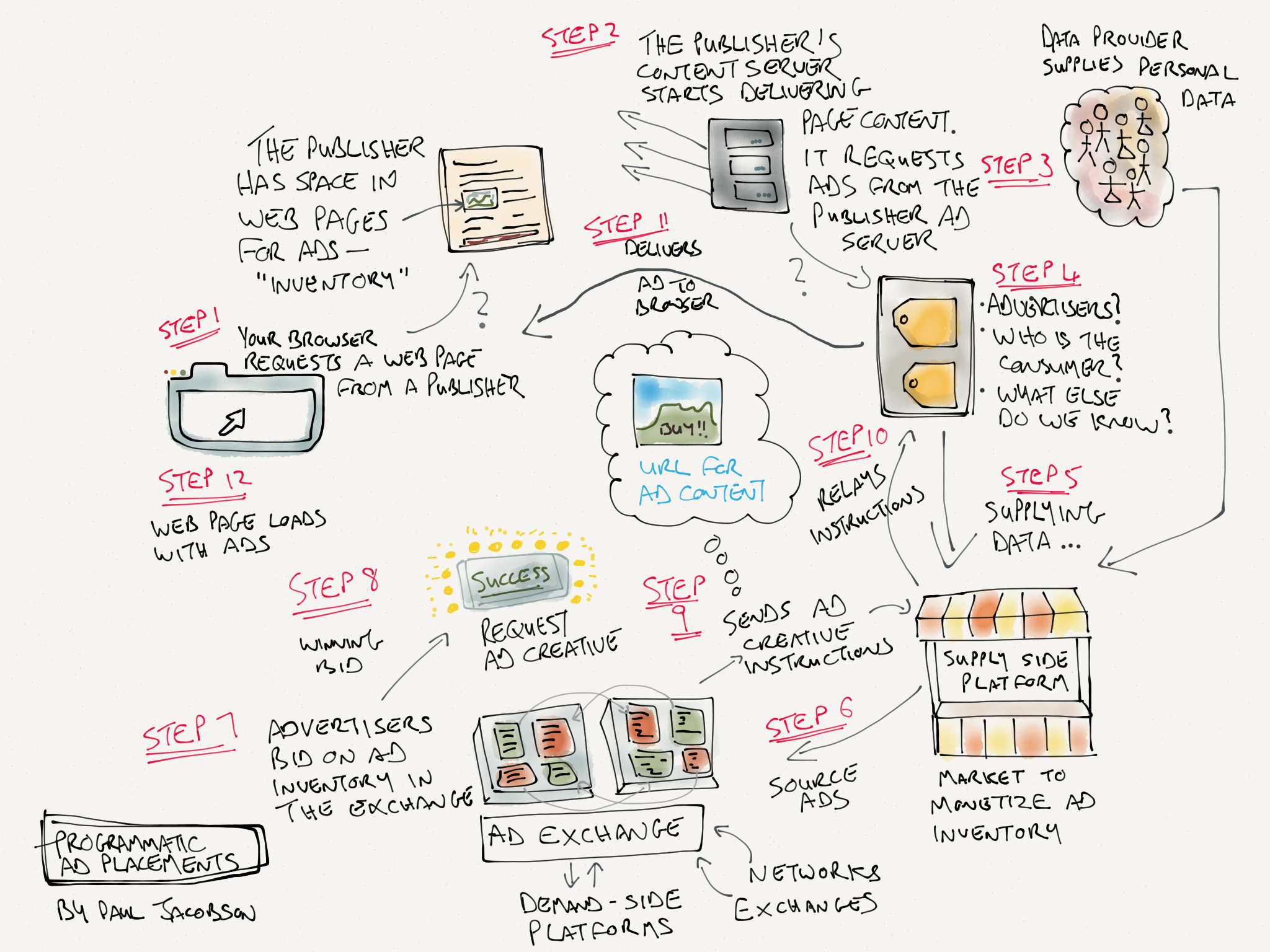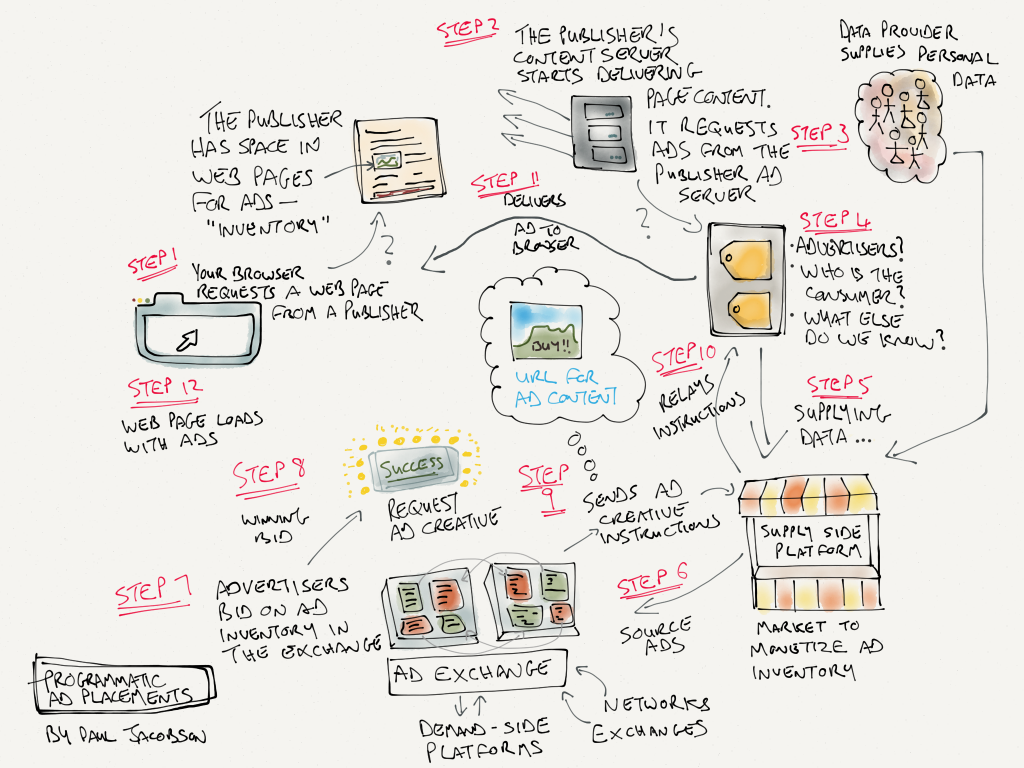This is the second of three parts of Your Handy Guide to Programmatic Advertising which, co-authored by Amit Halawa-Alon and Paul Jacobson. The first part is available through this link and here is the third part.
Programmatic advertising is far more flexible and can be very accurately tuned to suit website visitors’ expectations. A great way to understand how a programmatic ad placement works is using a fictitious example:
Case study
Let’s say Louise is looking for a birthday gift for her daughter who is obsessed with the Disney movie, Frozen. Louise spends some time browsing the web, searching for Frozen toys and accessories in her preferred search engine and online shopping websites. She finds a few options but nothing that really grabs her.

Along the way she browses to a popular news website. In order to load the news website, Louise’s browser connects to the news website’s server (also known as the “Publisher Content Server”) and requests the web page associated with the link Louise clicked on.
The Publisher Content Server recognizes that the web page Louise’s browser requested includes a space for an ad and it contacts the publisher’s Ad Server and requests an ad to insert into that space when it presents the complete web page to Louise through her browser.
The Ad Server reviews any information it may have about Louise based on previous interactions she may have had with websites it serves and then contacts a system known as a Supply Side Platform which is a system that aggregates and sources ads for placement on publishers’ websites (think of it as a sort of marketplace for ads which helps publishers find the best prices).
The Supply Side Platform also assesses information it or its external data sources may have about Louise and then makes an appropriate request for an ad from an Ad Exchange. The Ad Exchange is connected to another series of systems which could include Demand Side Platforms which advertisers use to present their offers for possible inventory which could, for example, include a specific price for women aged 30 to 35, living in a particular region and with a particular income range.
Advertisers using the Demand Side Platform participate in a bidding process and the winning bidder (often determined by price offered and the amount of attention the advertiser’s ads have received historically) is selected and the Demand Side Platform sends instructions to the Ad Exchange on how to retrieve the ad “creative” (typically text and images) which relays those instructions to the publisher’s Ad Server.
The publisher’s Ad Server then delivers the ad creative to Louise’s browser along with the rest of the web page content. Louise, of course, is unaware of this complex transaction which has occurred behind the scenes because it takes place so quickly. What Louise sees is the web page she requested which contains the ad which the Ad Server sourced.
What makes this whole process particularly interesting is that the ad that was delivered was sourced based on information which various servers had about Louise based on her search for the ideal Frozen gift for her little girl and other information about Louise which could include her general location and preferences. The result could be an ad for that perfect Queen Elsa dress at a local toy store and a relieved Mom.
In contrast to the more traditional ad placement model, the data-driven nature of programmatic advertising (specifically the combination of these smart systems and growing volumes of data about consumers’ online behavior and preferences) creates a number of powerful opportunities for publishers and advertisers, with consequential benefits for consumers themselves. We’ve alluded to some of those benefits, let’s explore them and others in some more detail.
Programmatic advertising’s tremendous value proposition
Programmatic advertising’s killer feature is dramatically improved ad relevance. Other features include transparency about pricing in the real-time bidding process (advertisers can see what other advertisers are bidding), speed and control.
For advertisers, programmatic advertising is an opportunity to direct ads at specific target markets almost instantaneously and far quicker than a human could place ads using the more traditional approach. The ad exchange model favors efficiency and speed through algorithmic trades where human intervention is more limited. This can be a concern for publishers who are accustomed to being more in control of the process.
That said, publishers are not at the advertisers’ or the exchanges’ mercy. Exchanges like Google’s DoubleClick Ad Exchange still give publishers a fair amount of control over the ads that will be placed on their websites despite placements being made indirectly.
According to a case study published by Google about the Washington Post Digital’s 2011 transition to the DoubleClick Ad Exchange –
Prior to this move, WPD was especially concerned about channel conflict and erosion of direct sales as partners began to buy through indirect channels. “For this reason, we were conservative about allowing our inventory to be branded on 3rd party platforms,” says Jeff Burkett, WPD’s senior director, ad innovations & client services. But with a strong drive to innovate, and reassured by the transparency and control offered by AdX, WPD took a step in a new direction and decided to sell its inventory branded.
Something to bear in mind is that publishers can make their inventory available anonymously or branded. If the inventory is anonymous, advertisers will know what sort of traffic to expect along with some features of the inventory without knowing which websites the inventory is available on. With branded listings, advertisers will know which websites the inventory is available on, along with other relevant details to inform their decision to bid for the space.
WPD’s experience seems to have been pleasantly surprising for the team:
With AdX, WPD can block ads, advertisers and ad categories, select which buyers it wishes to work with and when, and set specific price points per buyer – limiting channel conflict and maintaining price integrity. “We see clearly now who’s buying branded or anonymous inventory, and what demand-side platform they’re coming through,” he says, recalling instances where WPD was able to identify and resolve cases in which direct partners were buying inventory indirectly at lower CPMs.
…
“This has by far been the biggest experiment we’ve done, and our eCPM growth is far past what we thought this channel would provide,” says Jeff. He now tells other publishers that advertisers will pay the necessary rates for branded content, and that selling branded inventory through indirect channels won’t sacrifice brand and inventory value. “I don’t think publishers realize what a big opportunity it is,” he says.
The WPD’s experience goes some way to alleviating concerns about giving up the direct ad placement model which is still very popular today and shifting to the indirect programmatic advertising model with its many benefits.
Our third part will explore some of the exciting opportunities presented by programmatic advertising along with case studies and possible future uses of programmatic advertising. Subscribe to this blog, below, or follow us on Twitter (@imonomy) for updates.



0 Comments